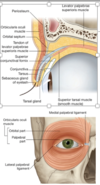week 2- eye Flashcards
(52 cards)
Decribe the four Layers of Fascia of the eye orbit
- periorbita & orbital septum & common tendonous ring
- bulbar sheath
- Fascia surrounding the extraocular muscles and recti to form check ligaments
- meningeal dura

Why does one see papilledema with increased ICP
the meningeal dura surrounds the optic nerve, arachnoid and pia and is continuous with the sclera. Consequently, when there is increased intracranial pressure, axoplasmic flow from the axons of the optic nerve is restricted, and they become swollen at the optic disc (papilledema)
define chalazion
Blockage and inflammation of a tarsal gland
Tarsal plates are associated with glands (tarsal glands).
what are the three muscles of the eyelid
- Levator palpebrae superioris
- Superior tarsal muscle
- Orbicularis oculi

what is the innervation of the eye muscles
- Levator palpebrae superioris-
CNIII
- Superior tarsal muscle-
sympathetic fibers
- Orbicularis oculi-
CNVII
what provides special and general sensory information to the eye
CN II optic- special sensory
CN V1- general sensory
What are the branches of V1
NFL
- Nasociliary
- Frontal
- Lacrimal

name the branches of the frontal nerve and what it innervates
supraorbital and supratrochlear nerves
Supraorbital=>brow, forehead, parts of scalp
Supratrochlear=> medial upper lid and forehead
the frontal nerve is a branch of the trigemmenal

what does the lacriminal nerve supply
lacrimal gland, Conjunctiva, lateral superior eyelid
Supplies innervation to the lacrimal gland—parasympathetics via greater petrosal n (CNVII) hitch a ride on this nerve
The lacrimal nerve runs along the lateral wall above the lateral rectus, supplies the lacrimal gland* and lateral upper lid

what are the branches of the nasocilary n and what does it supply
PLICA: posterior ethmoid, long ciliary, infratrochlear,communicating branch to ciliary ganglion, anterior ethmoid
- Anterior and posterior ethmoidal nerves: to sinuses and nasal cavity
- Long ciliary nerve: cornea, conjunctiva; sympathetic fibers to dilator pupillae, afferent limb of corneal blink reflex.
- Infra trochlear nerve: skin of medial eyelids, tip of nose, conjunctiva, lacrimal sac
- communicatingbranchto ciliary ganglion- sensory root

what innervates the corneal blink reflex
long cilliary branch of the nasocilliary nerve
wht provides parasympathetic innervation to the eye orbit
CN III and VII provide parasympathetic innervation to the orbit; these parasympatheticsalways travel on a branch of CN V.
review the anatomy of the cavernous sinus and the neurovasculature commonly impacted by a cavernous sinus thrombosis
O - oculomotor nerve
T - trochlear nerve
O - ophthalmic branch of trigeminal nerve
M - maxillary branch of trigeminal nerve
C - internal carotid artery
A - abducensnerve*
(T - trochlear nerve again)
O TOM CAT

ID the 2 branches of CN III and the muscles they innervate and which one carries PNS and SNS fibers
Superior branch
- levator palpebrae superioris
- superior rectus
- carries SNS fibers that innervate a smooth muscle(the superior tarsalm)
Inferior branch
medial and inferior rectus & inferior oblique
preganglionic PSNS to ciliary ganglion (visceromotor)

what can cause ptosis
Loss of function of either the levator palpebrae superioris (PNS) or superior tarsal muscle (SNS) results in a ptosis of the upper eyelid. Thus, ptosis may be caused by either CNIII or sympathetic damage.
Why is the position of PSNS fibers relative to CNV fibers clinically relevant? Third nerve palsies are often caused by aneurysms. This aneurysm will compress the parasympathetics first, and you will see a blown pupil before you see mm effects.
and aneurysm at junction of Pcomm(posterior communicating) & ICA
what are third nerve palsies typically caused by
aneurysm that will compress the parasympathetics first, and you will see a blown pupil before you see mm effects. Because of PSNS fibers relative to CNV fibers CNV is also impacted
what are the 3 sympathetics targets in the eye how to they reach their target
- Pupillary dilator
- Superior tarsal muscle
- Lacrimal gland
All sympathetics originate in the lateral horn of the spinal cord and synapse in the superior cervical ganglia. Post-ganglionics travel in a plexus surrounding the internal carotid (the carotid plexus), then take a convoluted route
describe the sympathetic path to the lacrimal gland
lateral horn of the spinal cord –> synapse in the superior cervical ganglia –> travel in the carotid plexus –> leave as the deep petrosal nerve + join the greater petrosal nerve–> nerve of the pterygoid canal, and follow the same path as the parasympathetics to the lacrimal gland

Inferior oblique
innervation
action
CN III
elevation, lateral movement and abduction
superior oblique
innervation
action
CN IV
Depression, Abduction, medial eye rotation
lateral rectus
innervation
action
CN VI
abduction
medial rectus
innervation
action
CN III inferior branch
adduction
superior rectus
innervation
action
CN III superior branch
elevation, adduction

inferior rectus
innervation
action
CN III superior branch
depression, adduction












